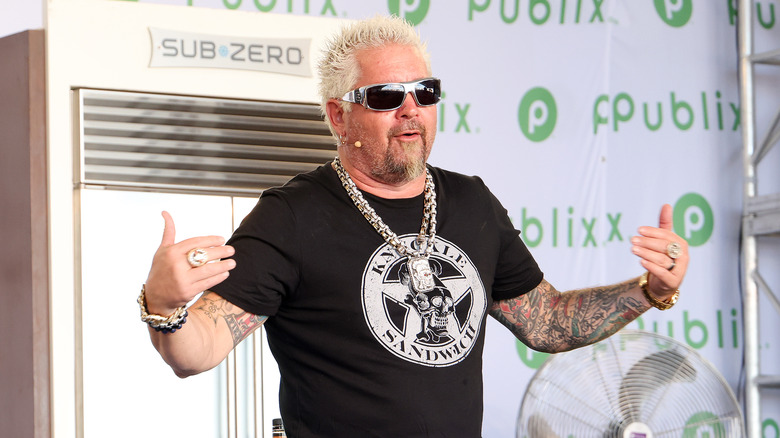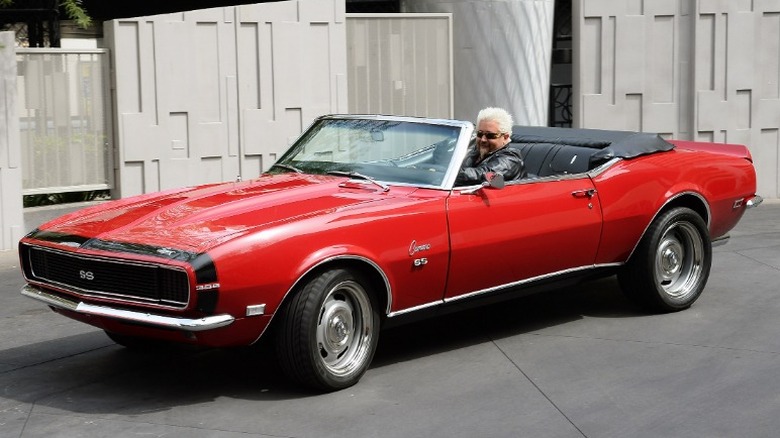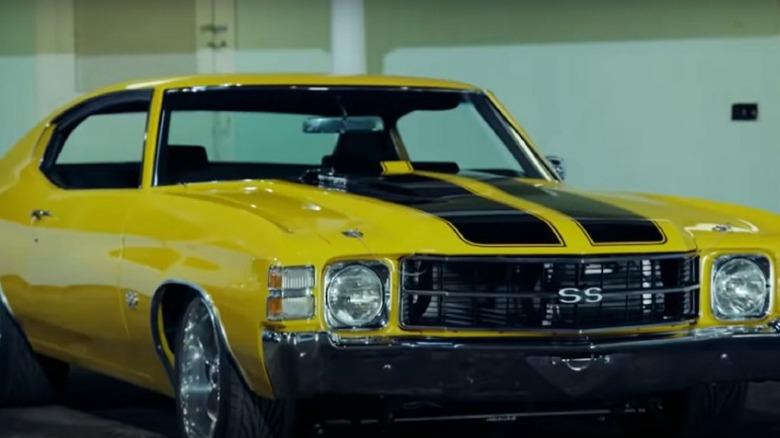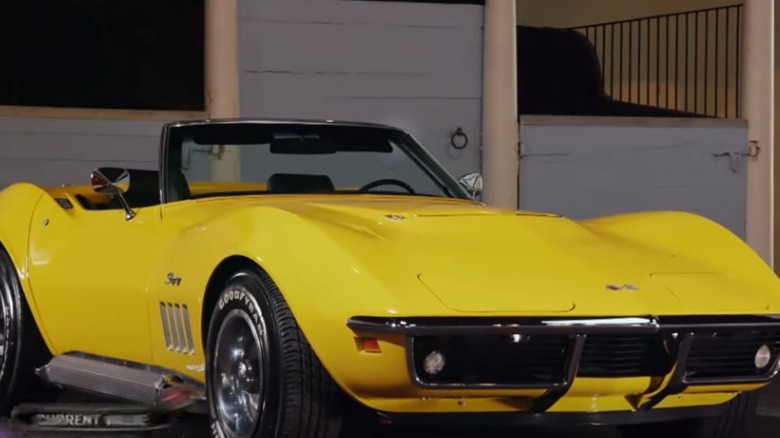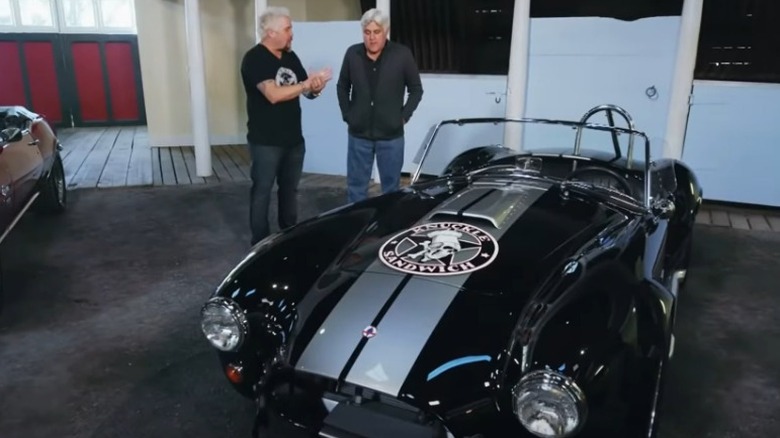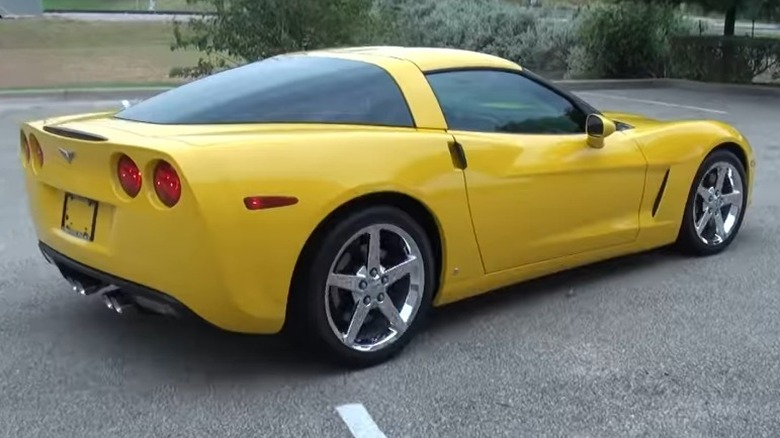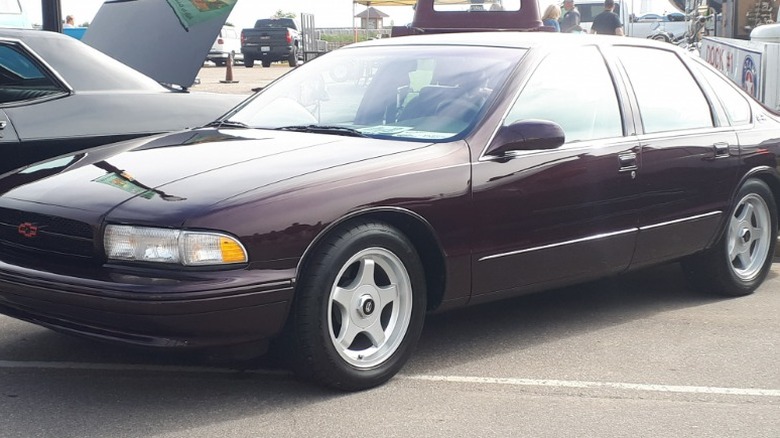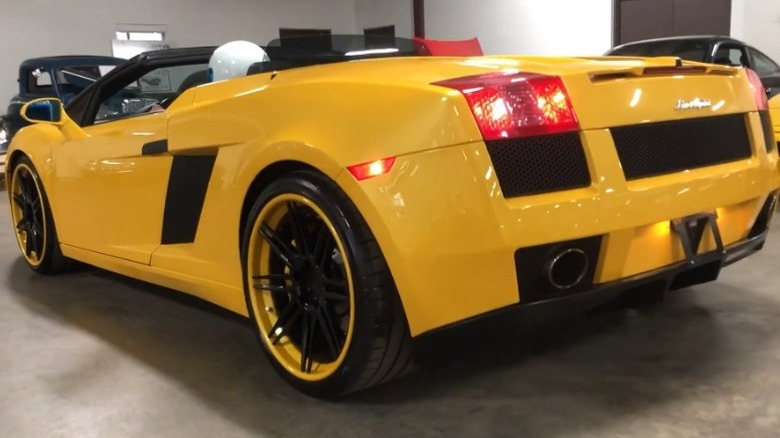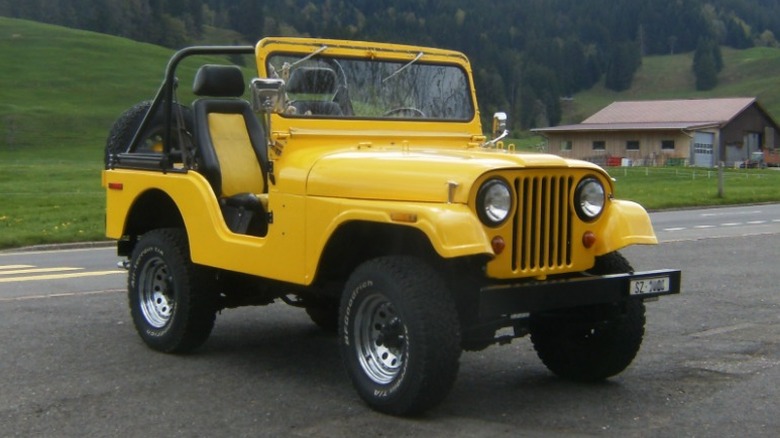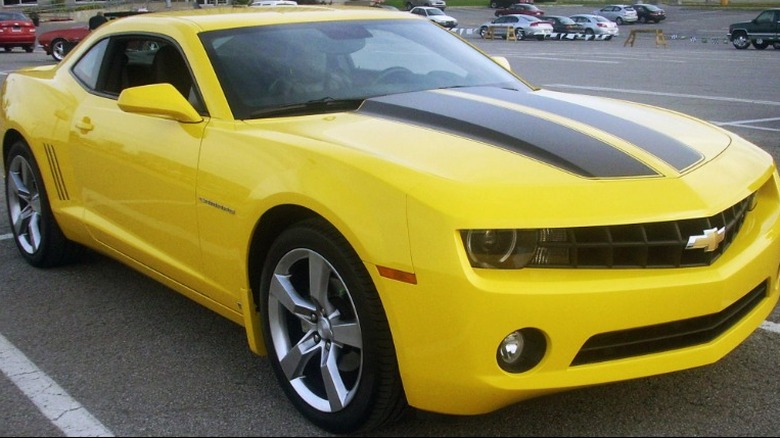The Bizarre Trait Many Of Guy Fieri's Cars Have In Common
Guy Fieri's favorite color is yellow. He dyes his hair yellow-blonde, and the king of food entertainment has more yellow cars in his impressive collection than any other color. Although his style is funny, a bit eccentric, and distinctly charismatic, Guy Fieri is a man of many talents, including being an Emmy Award-winning television presenter, an author, and a restaurateur. He owns restaurants in California and in big cities such as New York, Las Vegas, and Pittsburgh.
Fieri got his start on Food Network's "Food Network Star," and has appeared on numerous shows. He was crowned the winner of season two. However, his best-known program is "Diners, Drive-ins, and Dives." The show is a tribute to the 1950s when big-finned cars roamed the roads, and "greasy-spoon" diners were a favorite hangout. He told Food Network, "My parents were into macrobiotic cooking — vegetarian, nondairy, whole grains, no red meat. I started cooking when I was 10 because I just couldn't eat that stuff." Now his show often features food high in calories and low in nutritional content that many people love, such as chili burgers that ooze with cheese and anything with gravy on it.
Guy Fieri has been the dominant food entertainment personality for more than a decade, and he has assembled an extraordinary collection of his favorite cars in the process, many of them classic muscle cars. However, he also appreciates state-of-the-art automobile engineering and the unparalleled elegance of a high-performance supercar.
1968 Camaro Convertible
Food enthusiasts will recognize the cherry red 1968 Camaro driven by Guy Fieri in the opening sequence of his long-running Food Network show, "Diners, Drive-Ins, and Dives." Fieri, with his characteristic blonde spiky hair and dark sunglasses, sits behind the wheel of a cherry red convertible Camaro with the top down. Although the show used several different cars for the early episodes, Fieri chose the '68 Camaro Convertible when the show gained popularity and the producers asked for his preference. He explained: The open top made it easy to film him in the car. A coupé would have required a shot inside the car with very little room for the cameraperson and a large video camera.
Fieri purchased the '68 Convertible, making a complete frame-off restoration, including an upgrade with a GM ZZ502 crate engineproducing 500 horsepower and 567 pound-feet of torque, a complete Hotchkis suspension system, and a Tremec five-speed manual transmission. The result is a car worth an estimated $100,000.
Some viewers have wondered if Fieri drives his 1968 Camaro for personal use. According to People Magazine, "Fieri has a driver who gets him from place to place. The Camaro is trailered to each location. And it's the job of a crew member to get the car around the city they're filming in — Fieri only opens and closes the door for the camera." To add even more intrigue to the 1968 Camaro, on "Diners, Drive-Ins, and Dives," in the episode "Revved Up," VP Speed Shop built a duplicate car that Guy could not distinguish from the original.
1971 Chevelle SS Coupe
Fieri grew up a Chevy enthusiast, so when a neighbor decided to sell his 1971 Chevelle, Guy had to have it. Rumor has it, he offered the seller $12,000 he had been saving for just such an opportunity, along with free meals at his first restaurant for one year. The Chevelle was the first in Fieri's collection of classic cars most finished in yellow. He promised the seller he would never sell it.
1971 was a transition year for engine technology at GM. To prepare for the Corporate Average Fuel Economy (CAFE) standards enacted by U.S. Congress in 1975, the automaker dictated to all divisions (four years in advance) a requirement that all engines must run on unleaded fuel. The result was a detuning of Chevrolet engines starting with the 250-cubic-inch inline-six-cylinder with 145 horsepower, or the standard 307-cubic-inch V8, which produced a mere 140 horsepower.
An upgrade to the small-block V8 engine options offered the L65 350-cubic-inch engine with a two-barrel carburetor producing 245 horsepower, or the L48 350-cubic-inch engine with a four-barrel generating 270 horsepower. Chevrolet offered the big block LS3 402-cubic-inch engine with a four-barrel and the top-of-the-line LS5 454-cubic-inch engine with a four-barrel. All the engine options could be mated with the buyer's choice of any four-speed manual or three-speed automatic transmission. It is unclear which engine Fieri started with, but his Chevelle SS is now powered by a 496-cubic-inch mill and he added a rock-crusher rear end to improve off-road performance.
1969 Chevrolet Corvette
One of two Corvettes he owns, Guy Fieri described the unique circumstances under which he bought the yellow 'Vette on an episode of "Jay Leno's Garage." It was his birthday, the first time he purchased a car at an auction, and he completed the transaction over the telephone.
The 1969 Corvette was the second year of the C3 generation (produced from 1968 to 1982 model years). While the C2 Corvette generation had been well received by critics, most applauded the design changes for the C3 cars. Many chassis components and engines were carried over, but the new generation body and interior were new. The iconic car with its gently flowing curves that imitate a classic Ferrari is almost unrecognizable from present-day Corvettes. Although it is unknown which engine powers Fieri's Corvette, it is most likely the 427, given Fieri's thirst for power.
The 1969 Chevrolet Corvette Stingray 427 V-8 Turbojet produces 390 horsepower at 3,200 revolutions per minute and 460 pound-feet of torque at 3,600 rpm, sending power via a Muncie M20 wide-ratio, four-speed manual transmission to the rear wheels. The 'Vette accelerates to 60 miles per hour in an estimated 5.3 seconds, reaches the quarter mile in 13.9 seconds, and achieves a top speed of 137 miles per hour. According to Classic Cars, the current resale price of a 1969 Stingray Convertible equipped with a 427 varies from about $40,000 to $90,000.
2007 Shelby Cobra 427 S/C
Guy Fieri is a die-hard "bowtie" (Chevrolet) enthusiast and rumor has it at one point he claimed he would never buy a Ford. However, he owns a Shelby Cobra 427 S/C and describes it with great praise: "The horsepower to weight ratio is about the most ridiculous thing in the world." The black Cobra 427 that Fieri calls, "Live Fast," is a Continuation Series Cobra, built by a team at DenBeste Motorsports. The car, authorized by Shelby, retains the appearance and style of the original 1960s Cobras but is equipped with modern amenities.
A gift from the Cobra's designer, Carroll Shelby, Fieri added his own style with his Knuckle Sandwich brand logo painted on the hood over silver rally stripes. According to Ford Muscle Magazine, the naturally aspirated 500-cubic-inch engine is based on the big-block Ford FE V8 and generates 600 horsepower.
With a curb weight of 1,110 pounds, the Shelby Cobra 427 S/C accelerates from 0 to 60 miles per hour in 2.7 seconds, reaches the quarter mile in 12.2 seconds at 118.1 mph, and achieves a top speed of 165 miles per hour. Fieri commented: "I thought I really knew horsepower and torque and g-force. I can't believe the FAA doesn't require a pilot's license for these cars. A naturally aspirated 427 big-block is a can of whup-ass." The Cobra is so fast and loud, Fieri's son Ryder does not like riding in it.
2007 Chevrolet Corvette
The other Corvette Guy Fieri keeps in his collection is a 2007 model he nicknamed "Big Bite." He purchased the yellow 'Vette to celebrate his first Food Network cooking show gig. In 2007, Chevrolet offered the Corvette in three configurations: the standard Stingray coupe with a removable top, a convertible, and the high-performance Z06. The standard coupe and convertible models came with a 6.0-liter LS2 V8 that produced 400 horsepower and 400 pound-feet of torque. The Z06 came with a massive 7.0-liter (427) LS7 V8 that cranked out 505 horsepower and 470 pound-feet of torque.
Two special editions also debuted in 2007 with mostly cosmetic upgrades: the Indy Pace Car convertible with atomic orange paint, gold ribbon stripes, and custom seat embroidery, and a Ron Fellows Z06 with a white body and red fender stripes honoring the successful Corvette driver in the American Le Mans series. Chevrolet also offered the Z51 sport package for the standard mode, making it suitable for the track and hard driving while still providing a comfortable ride. It included more aggressive springs and dampers, enhanced stabilizer bars, improved cooling, larger cross-drilled brake rotors, and Goodyear Eagle F1 Supercar EMT tires.
The 2007 Z06 accelerated to 60 miles per hour in a mere 3.6 seconds and reached the quarter mile in 11.8 seconds, while the Z51-equipped coupe or convertible accelerated to 60 miles per hour in 4.2 seconds, reaching the quarter mile in 12.6 seconds. Although it is uncertain which model Guy Fieri owns, no doubt it is one of the high-performance Vettes.
1996 Chevrolet Impala SS
One of the few cars in Guy Fieri's collection that isn't yellow and perhaps the most "generic-looking" vehicle he owns is the dark green 1996 Chevrolet Impala SS. A typical ride for a retired couple or an undercover police officer, the low-key appearance of the Impala does not attract attention like most of Fieri's showy cars. However, even celebrities occasionally like to run errands without being hounded by the adoring public.
When GM reintroduced the Impala SS in 1994, family-sized muscle cars were all but dead. The company had been focusing its high-performance engineering on the Camaro and Corvette, both too small for a family of four or more. However, Impala proved to be a good choice. Over the three-year production period (1994-1996) Chevy sold 69,758 units at a base price of $22,495 (1994) and they flew off the dealer's lots. Despite its popularity, GM shut down production and switched the Arlington, Texas assembly plant to SUVs.
Derived from the Corvette's 300-horsepower engine but with 2-bolt main bearings, cast-iron cylinder heads, and a different camshaft, the LT1 produced 260 horsepower and 330 pound-feet of torque. Although the four-door sedan was big and heavy at 4,180 pounds, it was fast for its day, reaching 60 miles per hour in a respectable 7.5 seconds. The SS also handled well for its bulk, helped by robust anti-roll bars, 17-inch tires, and large 12-inch disc brakes. Today the 1994-1996 Chevy Impalas have become a favorite among classic muscle car collectors and perhaps it is the reason Fieri added one to his collection.
[Featured image by SsmIntrigue via Wikimedia Commons | Cropped and scaled | CC BY-SA 4.0]
2008 Lamborghini Gallardo
Guy Fieri strayed from his usual brightly colored array of American muscle cars, particularly Chevrolet models and convertibles, when he purchased a 2008 Lamborghini Gallardo — in bright yellow, of course. The supercar is equipped with a mid-mounted 5.0-liter that produces 512 horsepower at 376 pound-feet of torque. The automaker claims it accelerates to 60 miles per hour in a blistering 3.9 seconds and reaches a top speed of 196 miles per hour.
Gallardo's nearly ideal weight distribution of 42% up front and 58% in the rear along with a permanent all-wheel drive system (AWD) give the supercar excellent handling. While the AWD system normally operates at 42/58 ratio (front/rear) for best performance on dry pavement, nearly all of the engine's torque can be sent to either the front or rear wheels depending on driving conditions. The aluminum space frame with double-wishbone front and rear suspensions, and the AWD, make the Gallardo feel like it is glued to the road through the turns.
However, racetrack-level handling is not without its tradeoffs. The stiff suspension and firm seats can be stressful on a long trip, although the Gallardo, like most supercars, was designed for maximum performance over a relatively short period. Power-assisted rack-and-pinion steering gives the car quick reflexes and eliminates the sluggish feel of sudden directional changes characteristic of an AWD vehicle. The stopping power needed for the high-performance car is provided by ventilated Brembo anti-lock disc brakes featuring aluminum alloy, power vacuum calipers, and eight pistons in the front and four in the rear.
Aston Martin DB9
Aston Martin is an icon of British luxury made famous by appearances in the "James Bond" movie series. The DB9 grand tourer, available in a coupe and convertible (Volante) body style, was produced from 2004 through 2016. While it is unknown the model year of Guy Fieri's DB09, there is no doubt it is one of the most expensive cars in his collection.
In 2013, Aston Martin made several improvements to the DB9 including an upgrade in power with a 5.9-liter V12 engine producing 510 horsepower and 457 pound-feet of torque. The powerplant is connected to a 6-speed automatic transmission and accelerates the car to 60 miles per hour in 4.5 seconds and reaches a top speed of 186 miles per hour. Aston Martin also added ceramic brakes to the redesigned model. Aston Martin built the DB9 weighing 3,770 pounds with its VH platform chassis and high-quality lightweight aluminum components. Aston Martin says, "VH stands for Vertical/Horizontal, 'Vertical' represents the vertical integration of the platform's components both up and down the AM range. 'Horizontal' represents the horizontal spread of platform concept across to the other Ford brands ... " The design using non-structural body panels allowed AM to easily make inexpensive restyles and special editions.
All the Aston Martin DB9 models boasted a premium interior with luxurious hand-stitched leather. The rear seats are so small, only an infant could fit in them. However, the driver and front passenger seats are extremely comfortable. In 2013, the base model Aston Martin DB9 coupe had an MSRP exceeding $186,000 while the Volante convertible sold for over $201,000.
1976 Jeep CJ-5
Guy Fieri is passionate about cooking, his family, and cars. His choice for a family outing is a 1976 Jeep CJ-5. Although the car is over 40 years old, Fieri completely rebuilt the vehicle inside and out, and, of course, painted it yellow. The Jeep CJ-5 had a long and successful production run from 1955, when it was introduced by Kaiser, to 1983. The off-road 4x4 vehicle has gone through many changes during the run including significant modifications made by American Motors Corporation (AMC) in 1972. The company equipped the vehicles with its own engines which required a change to the chassis and body.
More changes were made to the CJ-5 in 1976. AMC removed the partially boxed and riveted parallel frame rails and replaced them with a boxed and welded frame with rails that widened towards the rear of the vehicle. The CJ-5 was given a more aggressive stance with a new windshield frame that leaned back. AMC retained the Dana 30 axle but changed out the Dana 44 rear axle for the company Model 20 axle, and the Dana 20 Transfercase was changed out for the superior Dana 300.
AMC upgraded the braking power by offering optional factory disc brakes and power brakes. The automaker offered several engine options including the inline-six, either the 232-cubic-inch or 258-cubic-inch I-6. At the top end, AMC installed the 304-cubic-inch V8 in the open-top Jeep making it a vehicle with a power-to-weight ratio most muscle car fanatics dream about, and one Guy Fieri would rave about.
[Featured image by Chris.urs-o via Wikimedia Commons | Cropped and scaled | CC BY-SA 4.0]
2011 Chevrolet Camaro
After a six-year hiatus, Chevrolet resumed production of the Camaro in 2009 with a modern interpretation of the classic first-generation 1969 model. Passionate about Camaros, Guy Fieri purchased a 2011 model to go with his 1968 Convertible, giving him two yellow Chevy Camaros some 43 years apart.
Chevrolet offered the Camaro in a coupe or convertible and several trim levels: A V6 powered LS (coupe only), 1LT and 2LT, and the V8-powered 1SS and 2SS. The LS and LT are equipped with a 3.6-liter V6 that produces 312 horsepower, 278 pound-feet of torque, and mates to a six-speed manual or an optional six-speed automatic. Performance tests conducted by Edmunds showed a 0 to 60 miles per hour time of 6.1 seconds for the slightly less powerful previous year's model with a manual V6.
Power-hungry buyers could opt for the SS equipped with a 375-cubic-inch small block V8 generating 426 horsepower with a manual six-speed transmission (400 horsepower with the automatic transmission). The Camaro SS 2-door Convertible accelerated from 0 to 60 miles per hour in 5 seconds, reached the quarter mile in 13.3 seconds, and achieved a top speed of 173 miles per hour. The base model LS included a host of features including automatic headlights, four-way manual front seats with power recline, a tilt-and-telescoping steering wheel, cruise control, OnStar, and a six-speaker stereo with CD player. Each trim level added more features and the 1SS included performance enhancements such as a rear lip spoiler and sport-tuned suspension.
[Featured image by Bull-Doser via Wikimedia Commons | Cropped and scaled | Public Domain]
